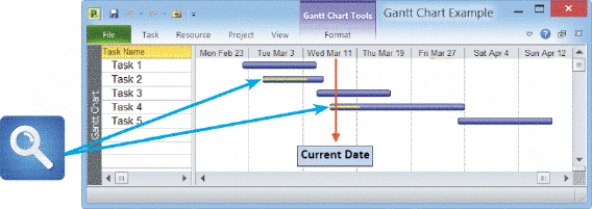A) category, which specifies the risk type
B) probability, which indicates the degree of adverse effect should the risk occur, on a scale of 1 to 10
C) impact plan, which identifies plans to control or limit the risk
D) contingency, which identifies a condition that would initiate the contingency plan
F) B) and D)
Correct Answer

verified
Correct Answer
verified
Multiple Choice
A event is a recognizable reference point that you can use to ____.
A) monitor progress
B) assign people
C) manage time
D) allocate money
F) B) and C)
Correct Answer

verified
Correct Answer
verified
True/False
In a PERT/CPM chart, each rectangular box, called a task box, has five sections that contain important information about a task.
B) False
Correct Answer

verified
Correct Answer
verified
Multiple Choice
In the end, every successful information system must ____.
A) support business requirements
B) stay within budget
C) be completed on time
D) not have any errors
F) A) and C)
Correct Answer

verified
Correct Answer
verified
Multiple Choice
The Apptivo ____ is free of charge with unlimited duration.
A) Full Plan
B) Enhanced Plan
C) Expanded Plan
D) Standard Plan
F) A) and B)
Correct Answer

verified
Correct Answer
verified
Short Answer
 -A(n) ____________________ represents the amount of work that one person can complete in one day.
-A(n) ____________________ represents the amount of work that one person can complete in one day.
Correct Answer

verified
Correct Answer
verified
Multiple Choice
Problems with timetables and project milestones can indicate ____.
A) recognition of task dependencies
B) continuity of project personnel
C) good control methods
D) personality conflicts among team members
F) A) and C)
Correct Answer

verified
Correct Answer
verified
Short Answer
MATCHING Identify the letter of the choice that best matches the phrase or definition. a.project management f.weight b.project coordinator g.bottom-up technique c.project leader h.dependent d.milestone i.concurrent e.constraint j.predecessor -An importance value assigned to an estimate.
Correct Answer

verified
Correct Answer
verified
Short Answer
The ____________________ handles administrative responsibilities for a project development team and negotiates with users who might have conflicting requirements or want changes that would require additional time or expense.
Correct Answer

verified
Correct Answer
verified
Multiple Choice
____ is a time estimate the project manager makes for a task.
A) The weight
B) The worst-case estimate
C) The best-case estimate
D) The probable-case estimate
F) A) and C)
Correct Answer

verified
Correct Answer
verified
True/False
Using prior experience to make time and cost estimates works best for large projects.
B) False
Correct Answer

verified
Correct Answer
verified
Multiple Choice
Many project managers find ____ charts more helpful for scheduling, monitoring, and controlling projects.
A) Gantt
B) PERT/CPM
C) index
D) task
F) None of the above
Correct Answer

verified
Correct Answer
verified
True/False
PERT/CPM and Gantt charts are mutually exclusive techniques.
B) False
Correct Answer

verified
Correct Answer
verified
Multiple Choice
The first step in the creation of a PERT/CPM chart is to ____.
A) determine the logical order of project tasks
B) identify the graphical planning aids to use
C) identify all the project tasks
D) determine the status of all tasks
F) B) and C)
Correct Answer

verified
Correct Answer
verified
Short Answer
 -In Microsoft Project, a(n) ____________________ is similar to a PERT chart.
-In Microsoft Project, a(n) ____________________ is similar to a PERT chart.
Correct Answer

verified
Correct Answer
verified
Multiple Choice
Project managers typically perform the tasks of ____.
A) project planning
B) project reconciliation
C) project scheduling
D) project monitoring
F) A) and D)
Correct Answer

verified
Correct Answer
verified
Multiple Choice
____ is open-source software that is supported by a community of users and developers.
A) GanttProject
B) Microsoft Project Standard
C) Microsoft Project Professional
D) Both b and c
F) All of the above
Correct Answer

verified
Correct Answer
verified
True/False
Although a Gantt chart provides more detailed information about a project, a PERT/CPM chart offers a rapid overview that graphically displays the timing, duration, and progress of each task.
B) False
Correct Answer

verified
Correct Answer
verified
Short Answer
 -A(n) ____________________ is a review of a project team member's work by other members of the team.
-A(n) ____________________ is a review of a project team member's work by other members of the team.
Correct Answer

verified
structured...View Answer
Show Answer
Correct Answer
verified
View Answer
Short Answer
 -The ____________________ is the time that a task is scheduled to begin.
-The ____________________ is the time that a task is scheduled to begin.
Correct Answer

verified
Correct Answer
verified
Showing 21 - 40 of 112
Related Exams